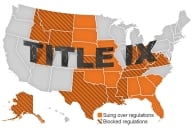You have /5 articles left.
Sign up for a free account or log in.
Much is justifiably made of how Alexander Hamilton’s hustler spirit can be found in his immigrant identity and difficult childhood. It is part of the brilliance of the show that Lin-Manuel Miranda gives a new nobility to America’s Founding by infusing it with a contemporary urban minority spirit.
But, seeing Hamilton in Chicago for a second time just the other week, I noted another key identity in those early scenes: Alexander Hamilton was a college student. In the second song, the fateful scene where our hero first meets his nemesis Aaron Burr, he recounts feeling disrespected by an administrator at Princeton, and subsequently punching him out. In the third, he sings about getting a scholarship to King’s College, now Columbia University.
This is Hamilton the all-out revolutionary. The man who is “young, scrappy and hungry”, who promises to fan sparks into flames, who sees the ascendancy of his name and the independence of his nation as inextricably intertwined, who will “lay down his life if it sets us free”.
The American Revolution needed that brash spirit, both to inspire it and to win a remarkably unlikely victory against a mighty empire with a mammoth army.
But as the show goes on, we see Hamilton evolving. His mentor and patron George Washington reminds him that “winning is easy, governing is harder.”
And so, Hamilton needs to cool his hot head, to make alliances, to negotiate and compromise, to build for the long term. He writes more than he fights, builds more than he protests. Instead of throwing rocks at the windows, he walks through the doors of fancy buildings into “the room where it happens”.
Most tellingly, Hamilton argues against involving the United States in France’s war with England, which Jefferson characterizes as a revolution which ought to remind American’s of their own ideals. “The people are leading” Jefferson insists. But Washington, with Hamilton at his side, responds: “The people are rioting – there’s a difference.”
Yes, there is – and being able to discern one from the other is the difference, in our era, between making noise and making lasting change. In Hamilton’s time, it was the difference between building a nation and being dead.
There are a variety of things here that are useful for progressive student activists to consider. How would you govern if you were in charge, and had all of the responsibilities of leadership, not just the luxury of advancing the causes that concern you the most?
I think about this when I run into diversity activists on college campuses who are angry at what they consider to be racist policies and curriculum and who say things like, “The only thing I care about is the success of students of color at this school.”
That’s the fiery spirit of the revolutionary Hamilton, the one that zeroes in on a narrow set of deficiencies without wondering how you build a nation after you win the revolution.
An interesting exercise to give those students: if you were the President of the College, if you had to think about everything from budgetary woes to the alarming number of Americans who say they have lost confidence in higher education, how would you lead? How would you make the changes you want to make AND get everything else you need to get done?
My whole life changed when someone offered me a similar challenge in my early twenties. I was a fierce protester in my undergraduate days at the University of Illinois, and I both believed in the causes I championed and enjoyed the attention that leading a march on the quad brought me. I took that same approach to my civic activities when I graduated. I regularly called out the leaders of global interfaith organizations for attracting audiences that were overwhelmingly white, male and elderly, and for running conferences that were full of boring panels.
“You need young people,” I shouted from the floor. “You need action.”
Several of those elders nodded approvingly at my antics. Protest, for me and for them, was both the means and end of progress.
But someone along the way played a far-seeing Washington to my young brash Hamilton. “Those ideas you have about the need for more young people and more action in interfaith work - those are great ideas. You know, instead of spending all your energy criticizing other people for not doing enough along those lines, you should spend some time thinking about how to make those ideas reality.”
A group of friends and I took that challenge seriously, and twenty years later the institution www.ifyc.org that emerged out of that moment has helped north of 500 campuses start or strengthen their interfaith programs.
Part of what I love about Hamilton is how Lin-Manuel Miranda manages to highlight how important both energies – the revolutionary spirit and the builder ethos – are to long-term social change. Perhaps the compromiser Hamilton, the one who sees in shades of gray and trades the geography of the nation’s capitol for a national bank, would have been ill-suited for the black-and-white thinking that inspired a revolution. And, of course, very few revolutionaries manage to build a nation, much less a democracy.
What if today’s student protesters, so effective at calling out what other people are doing wrong (the list of sins and mistakes is long and deserves to be shouted from the rooftops), can match the righteous revolutionary spirit with the ethos and skills of the nation-builder?





